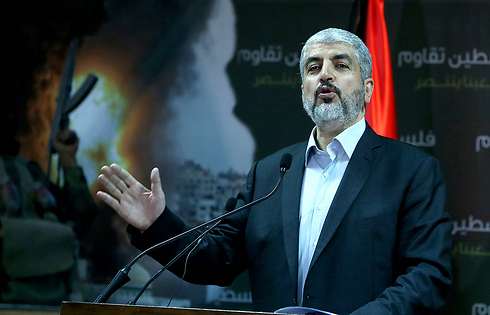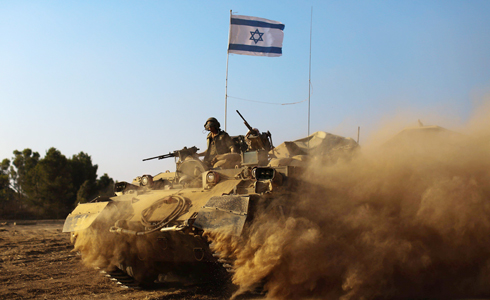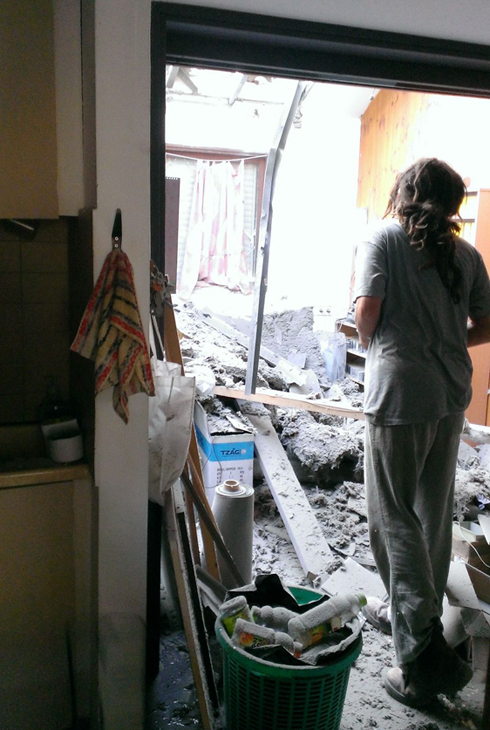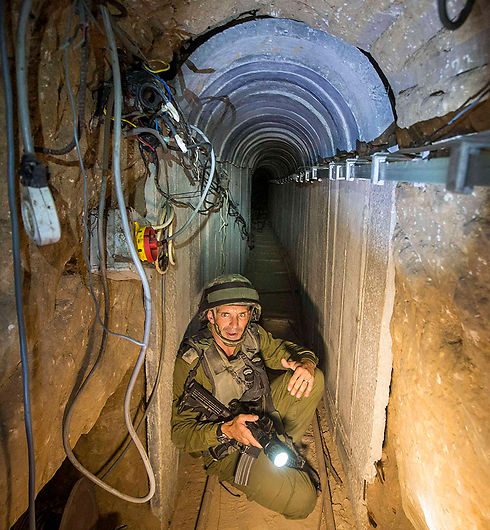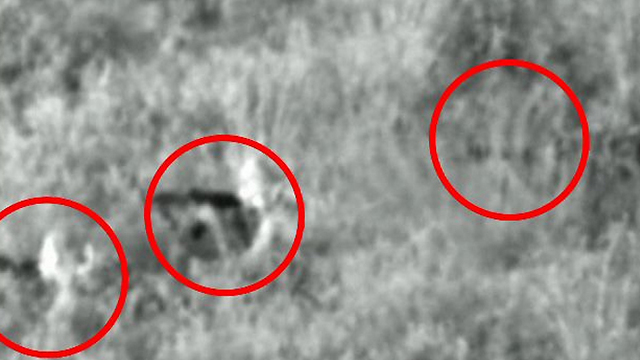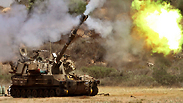
Tumbling into Gaza, and climbing out again
Israel and Hamas found themselves falling into a cycle of escalation, writes Nahum Barnea, but after Israel spent years ignoring the tunnel threat, will it really be so willing now to leave a fight it is winning while even one still stands?
Israel's Cabinet, meeting last week for one of its nightly discussions, waited testily for a speech by Khaled Mashal.
Mashal, the head of Hamas' political bureau, has had an upgrade in status. The fate of the ceasefire in Gaza, wanted by so many, rests in his hands, and the world was quick to recognize this. John Kerry, the top diplomat for the world's mightiest power, used his connections in Qatar to appease him (Kerry believed he was doing it for the government of Israel and with its blessing); Abu Mazen tried; Turkey tried.
Mashal had a choice of two paths: Either agreeing to a complete ceasefire, bringing an end to the fighting, sending the IDF troops home and opening a new era in Gaza, or to haggle to a so-called "continuous humanitarian ceasefire" - five days of calm on the military front for both sides, during which negotiations would be conducted on the rules of the day after the conflict.
But Mashal chose neither path. It could be that he wishes to bargain over the details; it could be that this for him is payback against the Egyptians, who publicly humiliated him; it could be that he does not have a mandate - the military wing in Gaza might agree, but the Hamas members in Qatar want more. The fact that in the meantime Palestinians are being killed in Gaza, including no few children, has not made him hurry any.
The most Mashal will – or can – give the world at the moment is an agreement to a ceasefire of a few hours, so that the population in Gaza can breathe some air and stock up on necessities.
It's fair to say waiting for Mashal to speak caused the prime minister some agony. In 1997, he gave the order for Mossad to eliminate Mashal in Jordan. The location was a gross error of judgment, the operation got into difficulties, and Netanyahu was forced to send the intravenous antidote to Amman, bringing Mashal back to life. Mashal is his nemesis.
In Israel, all eyes are on the finish line; this was the general atmosphere in the Cabinet meeting. Yes, there are more tunnels to destroy, but there is probably no way to get them all. In the meantime, more names are being added to the list of fallen soldiers and there is growing fear of a disaster by the IDF soldiers, or one befalling the Israeli or Gazan civilian population.
There are those in Israel, both in the defense and political leadership, who are tired of being dragged around in Hamas' wake. They are seeking a unilateral Israeli end to the operation. Israel would withdraw its ground troops from Gaza, but, if the rockets did not stop, attacks from the Air Force, Navy and artillery would also continue.
Israel has taken such unilateral steps in the past, for example at the end of Operation Defensive Shield in 2002, Operation Cast Lead in 2008, and more. Deterrence worked in those cases and resulted in a restoration of calm.
But deterrence can also be a decisive factor even when there is an agreement. The Second Lebanon War ended with UN resolution 1701, with the consent of both Lebanon and Israel. Hezbollah violated the demilitarization clauses in the resolution from day one, but there have been no missiles fired at Israel - not because of the agreement, but because of fear.
Once again Israel is demanding demilitarization - Gaza will not produce any more missiles. Netanyahu leapt on to this demand, first proposed by former IDF chief and defense minister Shaul Mofaz, pushing it in an international advocacy campaign. For advocacy purposes, this could be good, maybe for bargaining with the Americans, but the IDF believes that Hamas is far from willing to beat its swords into ploughshares. Resistance, says one of the generals, is the very nature of Hamas, in its DNA. With or without an agreement, rocket production will resume as soon as the war ends.
In short, it's time for Israel to take the initiative. Israel, not just Hamas, has ingrained traits, one being a reluctance to entrust its fate to others. Thus, the snowballing deterioration on the part of the both parties that led to the conflict in Gaza is somewhat reminiscent, on a lesser scale, of chapters of "The March of Folly" by historian Barbara W. Tuchman.
Pre-operation intelligence assessments painted a picture of a stricken Hamas: No salaries; the inability to meet the needs of the population; shunned by the Arab world, with the exception of Qatar; a shaky reconciliation with Fatah.
These assessments were correct. But then came the kidnapping of the three Israeli boys and Operation Brother's Keeper in its wake.
Israel rearrested the Palestinian prisoners freed in the Shalit deal and cracked down on Hamas infrastructure in the West Bank. Hamas in Gaza held its fire. The rockets began, fired by groups other than Hamas. Israel returned fire. There were two foiled attempts to attack IDF soldiers, and in the third attempt a Hamas man was killed.
This was the first step in the rolling decline. Israel was trying to calm things down, but then Hamas started firing too. When the rocket fire reached a level of 25-30 rockets per day, Israel felt compelled to respond. Both sides tumbled down into the second level of deterioration, then the third, which came in the form of an IDF ground operation.
This is the real story of Operation Protective Edge. There was no plot by Hamas, or an Israeli conspiracy. The deterioration was gradual, and, just as a snowball rolls downhill, it was propelled by its own momentum and the force of gravity.
Were there warnings when the Cabinet agreed to an Egyptian ceasefire in the middle of last week that Gaza was infested with tunnels, dozens of which led into Israel? The answer is yes.
In a years-long ongoing effort, Military Intelligence mapped the subterranean world in Gaza. The tunnels were not fully understood - not all the shafts and landmarks were identified, but the scale of the threat was known. This knowledge was not solely preserved for the prime minister, but was also available on YouTube in the form of a lecture (in Hebrew) given by the head of Military Intelligence, Major General Aviv Kochavi, at the Institute for National Security Studies in Tel Aviv.
The troops who entered Gaza were equipped with addresses, according to information gathered by Military Intelligence on suspected tunnel openings.
Netanyahu agreed to the ceasefire last week, despite knowing about the tunnels and the threat they posed. His decision, and that of the Cabinet, was made within the sphere of legitimacy. Bennett, who voted against it because of the tunnels, thought otherwise, but the cabinet had other considerations.
What is not legitimate is the gap between rhetoric and reality. Netanyahu was not the first to warn about the tunnels, but he did so halfheartedly. As prime minister he did not see the tunnels as sufficient threat to justify military action, before and during Pillar of Defense in 2012, and before and during Protective Edge. He chose to take a risk. When he told Channel 2's Udi Segal that he hoped that the problem of the tunnels could be solved politically, he knew that this was not grounded in reality.
Netanyahu, like others in the government, was surprised by Hamas' offensive ability, its fighting spirit and the subsequent number of fallen soldiers. Only he can answer the question of whether prior knowledge of the price would have prevented him from rolling into a ground operation. It's not certain that he is able to answer such a question - even to himself.
The IDF is acting on the assumption that there will be a period of calm followed by yet another round with Hamas. But this time, the damage to Hamas has been very great - the group lost 3,500 rockets, most of its tunnels leading into Israel, part of its chain of command, its war rooms, ammunition depots, and so on. The truce until the next round in Gaza will be long-lasting indeed.
The question is whether the residents of the Gaza perimeter - and residents of the South in general - are willing to keep living from round to round. Surely they deserve better than that.
And therefore the Israeli government must aim for a fundamental change in the reality in Gaza, and perhaps, finally, even change the very nature of Israel's relations with the Palestinians as a whole. In statements during this operation, Netanyahu has started to talk about Abu Mazen (Mahmoud Abbas) not as a problem, but rather as a solution. Israel's attempt to separate the West Bank from Gaza, to divide and conquer, has failed. Vision is needed. Hope is needed. Not only for Israelis, but Gazans too. For as hard as Israel flees Gaza, it gives chase with equal determination.
No heroes
Under Israeli rule, a three-settlement bloc was established in northernmost Gaza, between the Erez crossing and the sea - comprising Nisanit, Elei Sinai and Dugit. On the first night of the ground operation, an Armored Corps division took up position in the area. They found that Dugit, closest to the beach, was now a Hamas camp; Elei Sinai and Nisanit were in ruins. The division then headed further south to the outskirts of the Jabaliya refugee camp.
"You wouldn't recognize the Gaza Strip," said one of the commanders. "From the Tenzer Route (the road that crosses the Strip from north to south – in effect a continuation of Israel's Route 4) westwards there is one continuous urban community along the coast, including the construction of tall buildings. You wouldn't be able to tell Jabaliya and Shati apart. The low houses of the refugee camps have another two and three stories added, and there is more construction, underneath. "
It is that construction "underneath" that the IDF is mainly focused on.
"In the last five years, Gaza has reinforced and armed itself," the commander said. "We went to the hospital in Beit Hanoun and found 12 empty beds and underneath an ammunitions warehouse. The yard of an agricultural school for girls in Beit Hanoun was being used for rocket launches. There was a pneumatic system that could raise 24 Grad launchers to the surface. Imagine – a girls' school."
A Nahal infantry soldier who had just come from Beit Hanoun described the war from his perspective. "There were no face-to-face battles," he said. "We went in on foot. They shot at us with anti-tank missiles, with sniper fire, small arms. We hunted them. "
His comrade in arms, Sergeant First Class Oded Ben Sira from Nir Etzion, was killed by his side.
The commander confirmed this trend of fighting.
"It's true," he said, "there is little face-to-face fighting. They told me that this is not a high-intensity war. And I say, this is war in every sense.
"At the end of the day, they are not heroes. They do have special forces who show ability and willingness to sacrifice their lives, but most aren't. On Monday, for example, we encountered a squad of six. Some were killed and others fled. In skirmishes, they flee."
Has there been an armed Hamas fighter who has surrendered?
"No," he said. "So far this has not happened."
The officer was speaking last Tuesday afternoon, from a camp established the night before north of the Gaza border.
"(Hamas) encounters with citizens are far more radical than people think," he said. "The civilians want to leave, and Hamas pins them in their homes at gunpoint. From Hamas' perspective, anyone who moves from his home is dead. From my perspective, only those who shoot at me are dead. We use judgment. We abandoned the demolition of a house belonging to an Islamic Jihad commander as the house was full of women and children.
"But if they shoot at us from a house, we do return fire, including tank fire, including missiles. Sometimes we bring down the homes.
"The area around a school in Beit Hanoun had booby-trapped houses. Every house was suspicious. One soldier returned fire at a sniper in a window - and the whole house exploded in on its inhabitants. This has happened with several buildings. Beit Hanoun is easier than Saja'iyya. Saja'iyya was completely dug up."
The objective is to destroy the tunnels. "We call it forward protection," says the commander. "We go on the offensive in places intelligence tells us there are tunneling systems."
In the northern Gaza Strip, troops have identified three large tunnels, all of which emerge inside Israel. The largest tunnel, which leads to Nativ Ha'asara, is 27 meters deep - greater than a seven-story building - and is more than a kilometer long. Hamas diggers went through every layer of clay until they reached the sand underneath, which is more convenient for quarrying.
The IDF brought in industrial drills, the kind used for digging foundations for high-rise buildings. They drilled at key points along the path of the tunnel, inserted explosives, and detonated. One tunnel, totally completely annihilated.
"In another tunnel," said the commander, "we found the shaft, and it was very deep. The tunnel was booby-trapped. The IAF destroyed the open shaft, and now we are working on uncovering the tunnel. It's an immense engineering task.
"Deactivating a tunnel takes a lot of time. We are trying to do in days what in drills in Israel we did in weeks, and we are doing it in hostile territory. In Beit Lahiya, our engineering tools removed so much dirt, we created a huge quarry. "
What kind of an end to the operation do you want?
"I want peace," he said. "Quiet can be achieved in several ways. I don't decide which way we go."
Tunnels on the table
In summer 2010, a discussion took place in the Southern Command - one of many - on the issue of the tunnels. It was a fascinating discussion, precisely because there wasn't really anything new in it. Anyone who today pleads ignorance about the tunnels is lying to others - or to himself. For better or for worse, everything was on the table.
GOC Southern Command at the time, Yoav Galant, opened the debate. Terrorist organizations are preparing an attack via the tunnels, he said, high-quality attacks in real time, using extensive infrastructure throughout the sector. Hamas had taken advantage of the calm since Operation Cast Lead to improve its level of preparedness for terrorist attacks, and the tunnels were an important element in their planning.
The threat, Galant said, was expected to get stronger: The length of the tunnels was growing, the pace of work accelerating, and the ability to hide improving. The command made great efforts to address this issue in six areas, including defense, attack, intelligence and development of technology. These efforts must continue.
Subterranean warfare, said the general, is a method of fighting in which the enemy has shown operational capability and success, and against whose abilities there is no effective solution. The use of the tunnels is growing, a fact that demands creative solutions.
A complete solution, he concluded, would include exposure of the digging work, accurate detection of the tunnel routes and the ability to prevent, disrupt or wipe out the threat.
No less than seven different methods for dealing with the tunnels were raised during the discussion. Each had a more grandiose name than the last (there are no limits to creativity when it comes to inventing military names) but the results were ultimately disappointing. The Southern Command established a test site near Kerem Shalom, including a tunnel at a depth of 10 meters. And while these efforts bore no fruit, there was still great faith in the summer of 2010 that a solution would be found to the problem of the tunnels.
One idea included a system of sensors to detect all digging operations. But the system failed and the army stopped using it. Another system of sensors above ground was supposed to detect all activity carried out below it, but this system was not automated and required improvement.
A third invention was meant to locate tools that were being used underground; a fourth involved drilling into the ground, inserting poles, connecting to the water system and turning on the taps. The monetary cost was astronomical, and ultimately prohibitive.
The fifth system was designed to monitor excavation work from the air; the sixth aimed to reveal the route of a tunnel once it had been discovered. And finally, the seventh system was based on "statistical" drilling and explosions, and proved to have low efficiency.
In the absence of any redeeming technological invention, there was no way around dealing with the tunnels on three parallel tracks: intelligence, military operations beyond the Gaza border fence, and a sizeable financial investment in technological development. Intelligence-gathering efforts were made, but military operations beyond the fence were disabled at government direction, and money was not allocated. The tunnels were forced onto the backburner.
The data shows a clear shift after Operation Cast Lead. In the three years between the disengagement from Gaza in summer 2005 and Cast Lead in the winter of 2008-9, the fighters of the Southern Command embarked on 92 missions to locate the tunnels and demolish them. Tunnels were destroyed in, among others, Saja'iyya, Zeitun and Khan Younis - sites the IDF has returned to this past week. The ground on Israel's Gaza border was cleared during these missions.
At the end of Cast Lead, then-defense minister Ehud Barak ordered an end to missions beyond the fence. Galant claimed that the understandings reached with Hamas in the wake of the operation did allow for such actions, but Barak argued otherwise. Gabi Ashkenazi, chief of staff at the time, did not intervene.
But one incident did play a defining role for both sides. In November 2008, a tunnel leading from Gaza into Israel was discovered south of Wadi Gaza, in the central Strip. The decision was taken to attack it. Barak and Ashkenazi both wanted to strike from the air, but Galant claimed an air strike would not destroy the tunnel - it would only take out the mouth, thereby making it difficult to locate later. Barak was persuaded, and successfully dispatched a Paratrooper Reconnaissance Battalion (commanded by Yaron Finkelman, today commander of the Gaza border region).
Hamas responded with launches, and mutual escalation led the two sides to Operation Cast Lead, thwarting Barak's plans at the time to seek a hudna (temporary truce) with Hamas. Barak believed that operations beyond the fence should be avoided as much as possible; Galant believed the opposite.
This dilemma has stayed with Israeli decision-makers for the past six years. Among other things, it explains how Israel came to end up in Gaza today. One approach is to say, Hamas is like the grass - if you do not constantly mow it, it grows wild and becomes infested with deadly, venomous snakes.
The second approach is that Israel is a country surrounded by enemies. If it wishes to live in quiet, if it wants its residents to earn a decent living and have reasonable quality of life, it must prioritize the threats against it. Calm is not just a time-out between military operations - it is a value. Yitzhak Rabin used to order restraint on the Lebanese border during the summer so that the zimmers and holiday resorts in the area could make a living. The "War of Peace for Zimmers" was the bittersweet nickname for this policy.
Two events have changed the face of Gaza’s tunnel industry. The first was Operation Pillar of Defense, a year and a half ago. It was during this operation that Iron Dome proved its abilities and Hamas began to understand that the rockets alone would not bring glory. Second was the revolution in Egypt a year ago, that led to the rise of new president, General al-Sisi, who sealed the tunnels between Gaza and Egypt. Thus ended a thriving industrial sector, leaving highly experienced and skilled workers scrambling for employment. They found it in tunnels leading to Israeli communities.
Messianic times
Menashe Raz, a former radio broadcaster, tells the following story, heard from a fighter who had just been in Saja'iyya:
"In the days of waiting (for the ground operation to begin), we talked a lot about the operation. As the days passed, our understanding deepened that this was a war for our home, literally. No more explanation was needed."
"Still, there were those who did explain. Before we went into Saja'iyya, they gathered us up to listen to the words of a senior officer. The officer was Avichai Rontzki from Itamar (settlement), a former IDF chief rabbi. He delivered a messianic, fiery speech, which to me and many of my friends seemed strange and incomprehensible. He praised the miracle of God's army, an army in which my comrades and I did not know we were serving.
"War, you know, is terrible. Friends killed and wounded, and you're scared. You look around all the time, to make sure that your body is still in one piece.
"When they brought us back out, we just wanted to eat, shower, sleep and call home, mom and dad. We got close to Kibbutz Nahal Oz and then they gathered us together. You know how it is in the army - when told to gather, you gather. Waiting for us was a bunch of Breslev Hasidic Jews singing 'Messiah, Messiah', dancing and bouncing around. We formed a circle around them, and a bunch of fighters danced with them in ecstasy.
"I stood to the side, with the other fighters. We did not know how to take it. We really just wanted to eat. But then Breslevs fell silent, and one Orthodox man, dressed in black, with a beard and sideburns, read to us from the Torah."
The "Na-Nach-Nachmans" are a common sight along the Gaza border, as are their Lubavitch competitors. The military police has been blocking access to vehicles that do not belong to local residents, but somehow they are getting through anyway. So have other various religious types, with and without any authority, with and without any permission.
It is fair to assume that the religious soldiers - or some of them at least - find comfort from all this missionary activity. Others are vehemently opposed to it. The IDF is the Israel Defense Forces, they say, not the army of God - and they are right. Other, more critical issues aside, this nuisance is also something the IDF will have to take care of, but on a different day.










